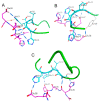Tetrapeptide Ac-HAEE-NH2 Protects α4β2 nAChR from Inhibition by Aβ
- PMID: 32872553
- PMCID: PMC7504039
- DOI: 10.3390/ijms21176272
Tetrapeptide Ac-HAEE-NH2 Protects α4β2 nAChR from Inhibition by Aβ
Abstract
The cholinergic deficit in Alzheimer's disease (AD) may arise from selective loss of cholinergic neurons caused by the binding of Aβ peptide to nicotinic acetylcholine receptors (nAChRs). Thus, compounds preventing such an interaction are needed to address the cholinergic dysfunction. Recent findings suggest that the 11EVHH14 site in Aβ peptide mediates its interaction with α4β2 nAChR. This site contains several charged amino acid residues, hence we hypothesized that the formation of Aβ-α4β2 nAChR complex is based on the interaction of 11EVHH14 with its charge-complementary counterpart in α4β2 nAChR. Indeed, we discovered a 35HAEE38 site in α4β2 nAChR, which is charge-complementary to 11EVHH14, and molecular modeling showed that a stable Aβ42-α4β2 nAChR complex could be formed via the 11EVHH14:35HAEE38 interface. Using surface plasmon resonance and bioinformatics approaches, we further showed that a corresponding tetrapeptide Ac-HAEE-NH2 can bind to Aβ via 11EVHH14 site. Finally, using two-electrode voltage clamp in Xenopus laevis oocytes, we showed that Ac-HAEE-NH2 tetrapeptide completely abolishes the Aβ42-induced inhibition of α4β2 nAChR. Thus, we suggest that 35HAEE38 is a potential binding site for Aβ on α4β2 nAChR and Ac-HAEE-NH2 tetrapeptide corresponding to this site is a potential therapeutic for the treatment of α4β2 nAChR-dependent cholinergic dysfunction in AD.
Keywords: Alzheimer’s disease; cholinergic deficit; molecular modeling; nicotinic acetylcholine receptor; peptide drugs; β-amyloid.
Conflict of interest statement
The authors declare no conflict of interest.
Figures






References
MeSH terms
Substances
Grants and funding
LinkOut - more resources
Full Text Sources
Other Literature Sources
Medical

